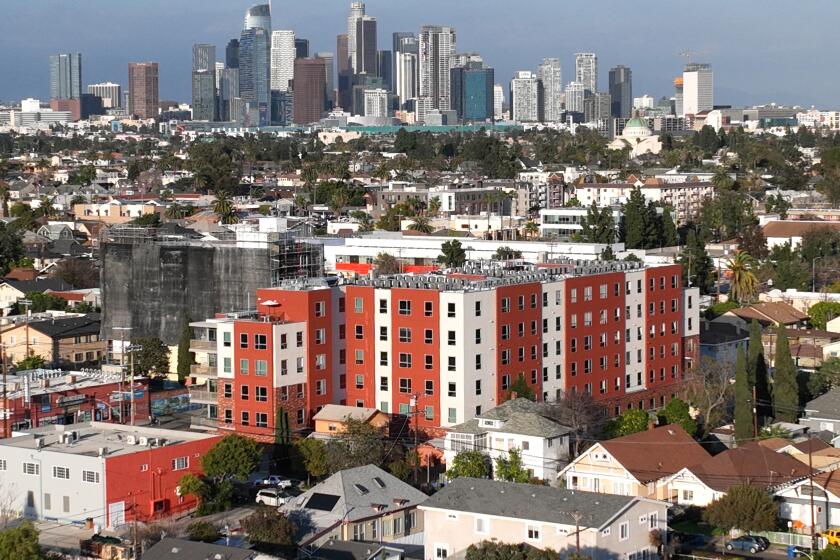Landscape designer Margie Grace takes her cues from the environment
- Share via
When it comes to creating beautiful, maintainable and environmentally-sensitive gardens, landscape designer Margie Grace takes her cues from the Earth itself.
After spearheading Grace Design and Associates for more than three decades, and curating 350-plus gardens, Grace conceived Sycamore Canyon, a verdant, 0.86-acre terraced garden landscape. With its whimsical, low-water, low-maintenance, fire-resistant design, it garnered her Designer of the Year in 2018 from the International Assn. of Professional Landscape Designers. It also happens to be her home.
“One of my goals was to see how low I could go on the water and still make it lush. I would do one part of the garden at a time, run to the water meter and see if I could do any more,” Grace said. “The trick is not as much plant material but other natural things — like a beautiful log, the un-patterned floor of gravel and the melange of beach pebbles in a variety of tones and sizes — that support the local biome, are nice on the eyeballs and easy on the pocketbook and water.”
Located in Montecito, where water allotment is strictly regulated, Sycamore Canyon is a study in sustainability and ingenuity, using only half the home’s designated water ration in the live-oak-laden, ivy-enveloped back yard.
Grace created distinct spaces with stone steps and grading, including six seating areas, a sandstone-rimmed pond and a four-foot-wide fire pit made from a $350 propane tank head from Baker Tankhead Inc. (“a lovely, earthy big chunk of yumminess” she wants everyone to know about).
The front yard, with its barrel cactus, ponytail palms and Australian cactus collection, pays homage to the iconic neighboring botanical garden, Lotusland. The backyard’s large, purple hoop sculptures echo her work at Greystone Mansion, the historic estate in Beverly Hills.
“There are strings of mirror garlands hanging on them so light is just dancing all through the garden. You can’t see that and not giggle,” said Grace, whose latest book, “Private Gardens of Santa Barbara,” is out this month.
What originally inspired your love of gardens and your work as a landscape designer?
Growing up we lived in Altadena, and mom would let us five kids borrow the Volkswagen bus and drive through the neighborhood and look at houses with these gorgeous trees and amazing architectural history. I’d say, ‘I like this one, I like that garden, I don’t like that one.’ The first step is just learning to look. Then the exercise becomes understanding what makes things great.
Maintaining a garden is a huge part of landscape design and installation.
The design, installation and maintenance happen on the continuum and have to all be in place. If you’re not considering what the maintenance is in the design, then your design has already failed. The maintenance doesn’t require horticultural knowledge, so if the garden needs pruning a couple of times a year, then we get a really fabulous arborist to handle the tree program. Then there are plants that are more like pets — I still have jobs from 30 years ago where I’m the only one who gets to touch and prune the Japanese maples.
What information do you need from clients when you first start a project?
We first ask our clients what they’re up to, how they live, what they care about and what are their priorities? If someone really wants a water feature, for example, we ask if that includes expensive koi, will it have plants in it or water that the kids can go in, is it the music of the water, the way it runs over rocks or the way it splashes? Then we’ve got our program, and depending on their resources, get as much of what they want with the resources they have.
How has climate change affected your work? What tricks allow outdoor spaces to be more efficient?
All these attempts we’ve made in these last two generations of sustainability and going green is just minimizing the impact of the things we build. We can use sustainable materials and reuse them until they drop dead, but the only thing that can mitigate is living ecosystems — the birds, bees, plants, soil and water. Sharing is also a huge component of sustainability. Your neighbor wants a chicken coop and you want a chicken coop — think about putting one on the property line with doors on either side; you both have eggs and when you go away for the weekend your neighbor covers you.
More to Read
Sign up for Essential California
The most important California stories and recommendations in your inbox every morning.
You may occasionally receive promotional content from the Los Angeles Times.






